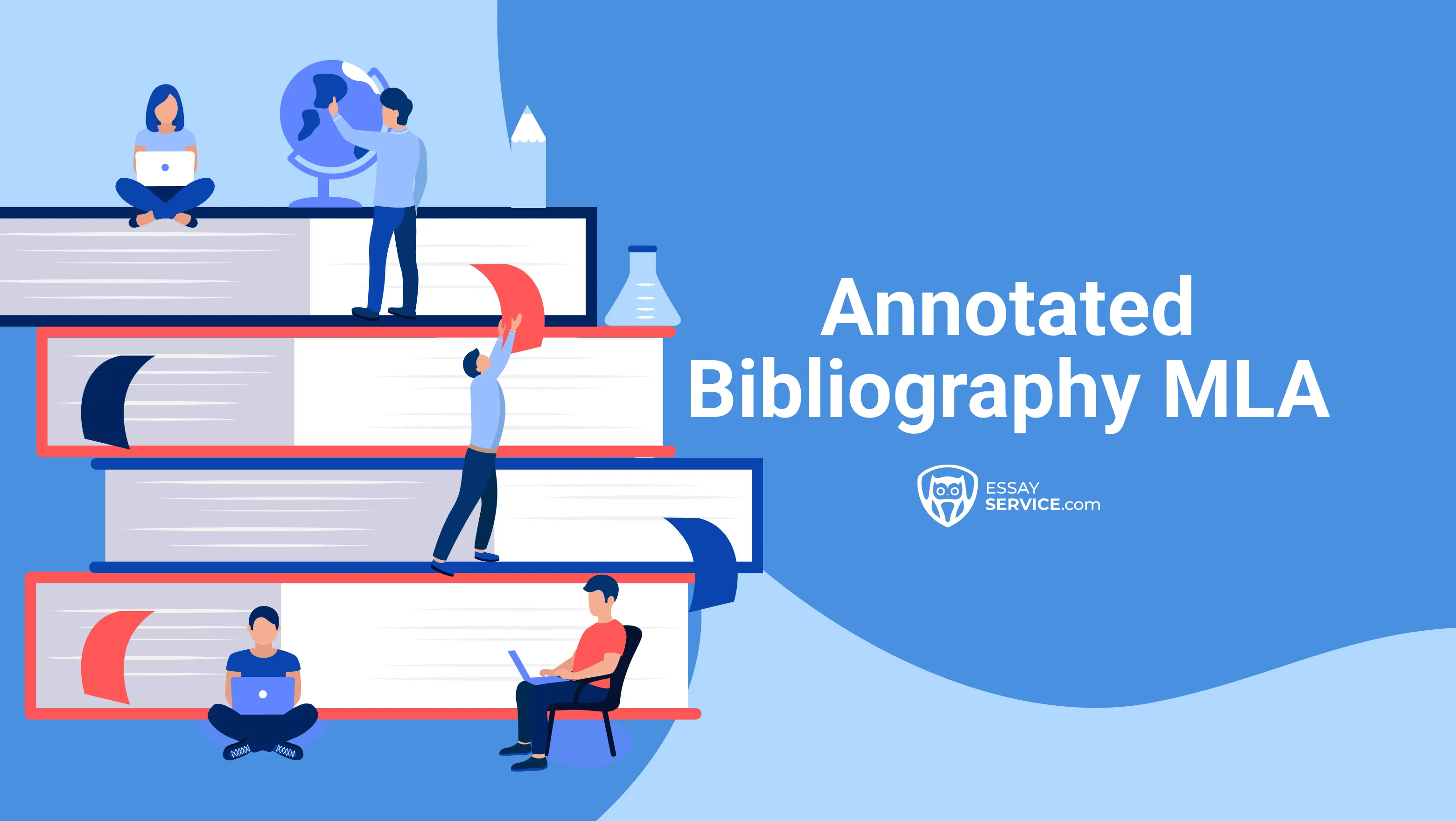If you’ve ever stared at an MLA assignment thinking, ‘what’s the difference between a works cited page and this?’ know that you’re not alone. MLA format is already picky about spacing, italics, and commas. Does it now want notes under each source? Yes. But here’s the thing: annotated bibliographies are more useful than they look. They help you process your research before you start writing.
This guide walks you through the MLA rules step by step, with examples and formatting tips that don’t assume you already know everything.
And if the whole thing still feels like a headache, EssayService’s annotated bibliography writer can take it from here.
What Is an Annotated Bibliography MLA Format?
An annotated bibliography in MLA format lists cited sources followed by short descriptions and evaluations. It helps you summarize, analyze, and reflect on each source’s value for your research.
MLA style requires double spacing, a hanging indent, and clear, concise annotations for each entry.

How the MLA Annotated Bibliography Format Actually Works
Do you know that moment when you think you're done with your paper and then your professor drops the ‘annotated bibliography’ bomb? And not just any bibliography: MLA with all its little spacing rules, indents, and font requirements.
So let’s just clear this up. If you’re working on an annotated bibliography MLA format assignment, here’s what you need to do:
- Title the page: Literally just write ‘Annotated Bibliography’ and center it.
- Use double spacing: From top to bottom and no skipping extra lines between entries.
- Add your citations: MLA style lists author, title, publisher, and year in the right order.
- Hanging indent: Every line after the first in your citation should follow the previous one by half an inch.
- Write your annotation: One paragraph per source, around 3 to 5 sentences.
- Keep the font basic: Times New Roman or Arial, 12-point.
- Left-align everything else: Except for the title at the top.
- Alphabetize your sources: Go by the author’s last name, just like in a Works Cited page.
No one loves formatting. But once you knock it out, your sources will start making sense in your head.
Simple MLA Annotated Bibliography Template
Here’s an MLA annotated bibliography template you can copy and use for any research assignment.
Citation (in MLA format):
- Author’s Last Name, First Name. Title of Source. Publisher, Year.
Annotation paragraph (3-5 sentences):
- What’s the source about? One sentence explaining the topic or argument.
- How does it support your research? Say what makes it useful or relevant.
- What’s the author’s perspective or method? Mention bias, credibility, or approach.
- Will you use it in your paper? If yes, explain how.
How to Write an Annotated Bibliography MLA Style
Here’s how to get through your annotated bibliography without rage-quitting:
- Start with the MLA citation. It tells us what you’re working with.
- Sum up the source in a sentence or two. What’s the main point, and who’s it written for?
- Say something about the author. Are they credible? Do they have a clear angle or bias?
- Explain why this source is important. Does it support your argument? Offer something new?
- Mention what stands out. Maybe it’s strong evidence or missing something big.

An MLA Annotated Bibliography Example
Now that you understand how to put together an annotated bibliography following MLA guidelines, let's take a practical look. We'll use an example to break down the specific details. This walkthrough will help you get a clear picture of how to implement these guidelines when you're tasked with 'write my annotated bibliography' in your academic journey.
Example of an MLA Annotated Bibliography with Source Evaluations
Here’s what an MLA entry looks like when you not only cite the source but also explain why it’s worth using. It combines correct formatting and a thoughtful take on the source.

MLA Annotated Bibliography Website Example
The example below shows how to annotate an entry for an online article. There’s a citation, followed by a short note that explains the main points.
.webp)
How to Annotate a Book in an MLA Format
This example walks you through how an MLA annotation looks for a book. As you can see, it starts with the full citation and then adds a short paragraph as a summary of how the book connects to your research.
.webp)
How to Annotate a Visual Source in MLA Format
When citing an image or video in MLA, focus on more than just the title. Whether it’s a painting, photo, film still, or infographic, MLA wants you to describe what it shows, who made it, and why it matters to your research. Here’s an example of annotated bibliography MLA:
.webp)
How to Annotate an Audio Source in MLA Format
When you're citing a podcast, interview, or any audio recording in MLA, the key is to show what it's about, who’s behind it, and how it adds to your research. Keep it short, specific, and easy to follow. Here’s an example:
.webp)
Tips for MLA Annotated Bibliography
Here’s what to do when writing an MLA format for annotated bibliography.
- Explain how each source supports your topic.
- Keep annotations between 100-150 words.
- Include a quick critique of credibility or bias.
- Use verbs like 'argues,' 'examines,' or 'challenges.'
- Avoid filler and get to the point fast.
- Don’t repeat the citation info in the annotation.
- Proofread.
Final Thoughts
An MLA annotated bibliography is a way of showing you’ve done the reading and the thinking. Each source you include should serve a purpose. Your annotations explain why that article, book, or podcast matters to your research and what it brings to the table.
And if you’re still confused, EssayService’s writing paper service can help with citations, summaries, or the whole thing.
Frequently Asked Questions
What Does an MLA Style Bibliography Look Like?
It’s a list of sources. Each source includes its short summary and why you used it in your paper.
How Long Should an MLA Annotated Bibliography Be?
The length depends on the number of annotations you used. Each annotation is about 100-150 words.
How Do You Format an Annotated Bibliography in MLA?
Use 12-point font, double spacing, and hanging indents. Title the page ‘Annotated Bibliography’ and list entries in alphabetical order.

Jennifer is a student currently pursuing a Journalism major. She oversees the EssayService blog team and uses her journalism skills to ensure all blog posts are accurate, trustworthy, and engaging.
- Cornell University Library. (n.d.). How to prepare an annotated bibliography. Cornell University. https://guides.library.cornell.edu/annotatedbibliography
- University of Nevada, Reno Libraries. (n.d.). MLA citation: Annotated bibliography. https://guides.library.unr.edu/mlacitation/annotatedbibliography
- Xavier University Writing Center. (2017). Annotated bibliography MLA style. Xavier University. https://www.xavier.edu/writingcenter/documents/AnnotatedBibliographyMLA.pdf
New posts to your inbox
Your submission has been received!



